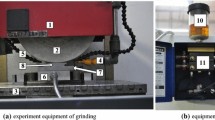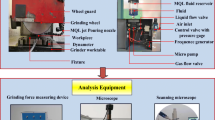Abstract
In this study, a new type of self-lubricating nanoparticle diamond grinding wheel with MoS2 and TiO2 nanoparticles as filling materials was proposed. According to the macro parameters (grinding force) and micro parameters (surface roughness, surface morphology, grinding wheel wear), the lubricated characteristic on tool and workpiece surface with various concentrations of nanoparticles was studied. The research indicated that the composite nanoparticles can effectively improve the lubricated characteristic of the tool. The nanoparticles released from the grinding wheel can participate in lubrication and decrease the adhesion of abrasive grains to the workpiece surface, so as to enhance the surface quality of the workpiece. Moreover, there is a suitable addition range of composite nanoparticles in the grinding wheel. Adding too little or exceeding this range will weaken the friction reduction performance of the nanoparticles. It had the best lubrication performance and surface quality of the workpiece at a nanoparticle volume concentration of 8%.












Similar content being viewed by others

Availability of data and materials
The authors confirm that the data and material supporting the findings of this work are available within the article.
References
Liu Y, Li BZ, Wu CJ, Kong LF, Zheng YH (2018) Smoothed particle hydrodynamics simulation and experimental analysis of SiC ceramic grinding mechanism. Ceram Int 44:12194–12203
Dai JB, Su HH, Zhou WB, Yu TF, Ding WF, Zhang QL, Zheng YH (2018) Finite element implementation of the tension-shear coupled fracture criterion for numerical simulations of brittle-ductile transition in silicon carbide ceramic grinding. Int J Mech Sci 146-147:211–220
Shen JY, Wang JQ, Jiang B, Xu XP (2015) Study on wear of diamond wheel in ultrasonic vibration-assisted grinding ceramic. Wear 332-333:788–793
Fiocchi AA, Eduardo DASL, Lisboa-Filho PN, Fortulan CA (2016) The ultra-precision Ud-lap grinding of flat advanced ceramics. J Mater Process Technol 231:336–356
Mcnamara D, Alveen P, Carolan D, Murphy N, Aloz L (2014) Micromechanical Study of Strength and Toughness of Advanced Ceramics. Procedia Mater Sci 3:1810–1815
Heinzel C, Kolkwitz B (2019) The impact of fluid supply on energy efficiency and process performance in grinding. CIRP Ann 68:337–340
Naskar A, Singh BB, Choudhary A, Paul S (2018) Effect of different grinding fluids applied in minimum quantity cooling-lubrication mode on surface integrity in cBN grinding of Inconel 718. J Manuf Process 36:44–50
Wang YS, Zou B, Wang JC, Wu Y, Huang CZ (2020) Effect of the progressive tool wear on surface topography and chip formation in micro-milling of Ti–6Al–4V using Ti(C7N3)-based cermet micro-mill. Tribol Int 141:105900
Deng H, He J (2017) A study of the grinding performance of laser micro-structured coarse-grained diamond grinding wheels. Int J Adv Manuf Technol 93:1989–1997
Li CH, Du C, Liu GY, Zhou Y (2010) Performance evaluation of minimum quantity cooling lubrication using CBN grinding wheel. Adv Mater Res 97-10:1827–1831
Zhang DK, Li CH, Jia DZ, Zhang YB, Zhang XW (2015) Specific grinding energy and surface roughness of nanoparticle jet minimum quantity lubrication in grinding. Chin J Aeronaut 28:570–581
Zhang JC, Li CH, Zhang YB, Yang M, Jia DZ, Liu GT, Liu YL, Li RZ, Zhang NQ, Wu QD, Cao HJ (2018) Experimental assessment of an environmentally friendly grinding process using nanofluid minimum quantity lubrication with cryogenic air. J Clean Prod 193:236–248
Zhang XP, Li CH, Zhang YB, Wang YG, Li BK, Yang M, Guo SM, Liu GT, Zhang NQ (2017) Lubricating property of MQL grinding of Al2O3/SiC mixed nanofluid with different particle sizes and microtopography analysis by cross-correlation. Precis Eng 47:532–545
Xu ZY, Xu Y, Hu KH, Xu YF, Hu XG (2015) Formation and tribological properties of hollow sphere-like nano-MoS2 precipitated in TiO2 particles. Tribol Int 81:139–148
Xu Y, Hu EZ, Hu KH, Xu YF, Hu XG (2015) Formation of an adsorption film of MoS2 nanoparticles and dioctyl sebacate on a steel surface for alleviating friction and wear. Tribol Int 92:172–183
Hu KH, Xu Y, Hu EZ, Guo JH, Hu XG (2016) Rolling friction performance and functional conversion from lubrication to photocatalysis of hollow spherical nano-MoS2/nano-TiO2. Tribol Int 104:131–139
Tomala A, Ripoll MR, Gabler C, Remškar M, Kalin M (2017) Interactions between MoS2 nanotubes and conventional additives in model oils. Tribol Int 110:140–150
Zhao J, He YY, Wang YF, Wang W, Yan L, Luo JB (2016) An investigation on the tribological properties of multilayer graphene and MoS2 nanosheets as additives used in hydraulic applications. Tribol Int 97:14–20
Mao C, Huang Y, Zhou X, Gan HY, Zhang J, Zhou ZX (2014) The tribological properties of nanofluid used in minimum quantity lubrication grinding. Int J Adv Manuf Technol 71:1221–1228
Mao C, Zhou FJ, Hu YL, Cai PH, Jiang YF, Bi ZM, Peng GQ (2019) Tribological behavior of cBN-WC-10Co composites for dry reciprocating sliding wear. Ceram Int 45:6447–6458
Zhang YB, Li CH, Jia DZ, Zhang DK, Zhang XW (2015) Experimental evaluation of the lubrication performance of MoS2/CNT nanofluid for minimal quantity lubrication in Ni-based alloy grinding. Int J Mach Tools Manuf 99:19–33
Lu T, Huang SQ, Yi F, Wan JA, Xu XF (2017) Study on self-lubrication performance of phenolic resin grinding wheel with liquid lubricant/cyclodextrin inclusion compound as filler. J Mech Eng 17:174–185
Zhang JQ, Wang WS, Yu TB (2013) Experimental study on performance of nano-ceramic bond for ultra-high speed ceramic CBN grinding wheel. Nat Sci 04:134–139
Guimarães GMDF, Bronze-Uhle ES, Lisboa-Filho PN, Fugolin APP, Borges AFS, Gonzaga CC, Pfeifer CS, Furuse AY (2020) Effect of the addition of functionalized TiO2 nanotubes and nanoparticles on properties of experimental resin composites. Dent Mater 36:1544–1556
Chen ZZ, Qi H, Zhao B, Zhou Y, Shi LW, Li HN, Ding WF (2020) On the tribology and grinding performance of graphene-modified porous composite-bonded CBN wheel. Ceram Int
Acknowledgment
The authors would thank Dr. Dongdong Wen for their experimental support and analysis assistance.
Funding
This project was supported by the National Key R&D Program of China (grant no. 2018YFB2001400), the National Natural Science Foundation of China (grant no. 51875200), the Science and Technology Planning Project of Hunan Province (grant no. 2018RS3100), and Hunan Provincial Innovation Foundation for Postgraduate (grant no. CX20190927).
Author information
Authors and Affiliations
Contributions
Xiaohong Zhang: conceptualization, methodology, software, writing (original draft preparation), visualization, validation, investigation, reviewing, and editing. Ruyi Jiang: methodology, software, validation, writing (reviewing and editing), and visualization. Chao Li: supervision, reviewing, and editing. Zhaoyao Shi: supervision, reviewing, and editing. Dongdong Wen: supervision, reviewing, and editing. Zhuoran Wang: supervision, reviewing, and editing. Zejian Shi: supervision, reviewing, and editing. Jie Jiang: supervision, reviewing, and editing.
Corresponding author
Ethics declarations
Competing interests
The authors declare that they have no competing interests.
Ethical approval
The article follows the guidelines of the Committee on Publication Ethics (COPE) and involves no studies on human or animal subjects.
Additional information
Publisher’s note
Springer Nature remains neutral with regard to jurisdictional claims in published maps and institutional affiliations.
Rights and permissions
About this article
Cite this article
Zhang, X., Jiang, R., Li, C. et al. Experimental evaluation of the lubrication performance of MoS2/TiO2 nanoparticles for diamond wheel bond in silicon carbide ceramic grinding. Int J Adv Manuf Technol 113, 2385–2393 (2021). https://doi.org/10.1007/s00170-021-06673-8
Received:
Accepted:
Published:
Issue Date:
DOI: https://doi.org/10.1007/s00170-021-06673-8



